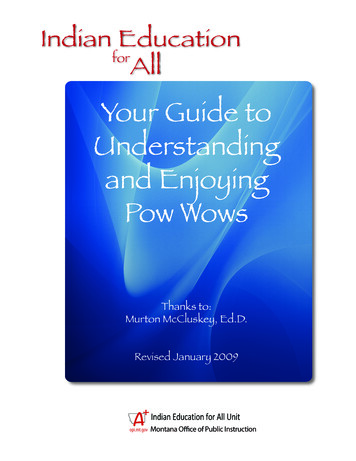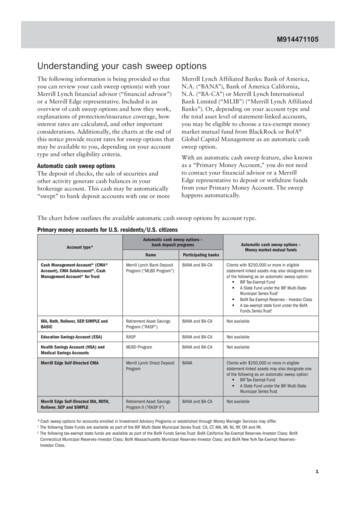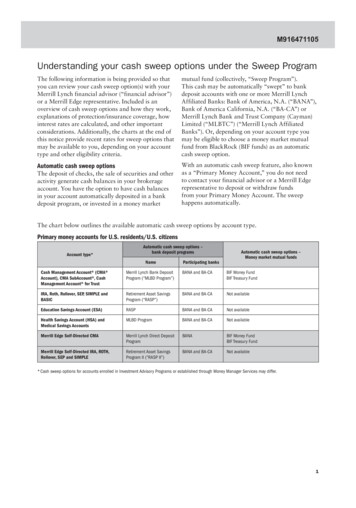
Transcription
Indian EducationforAllYour Guide toUnderstandingand EnjoyingPow WowsThanks to:Murton McCluskey, Ed.D.Revised January 2009
TABLE OF CONTENTSIntroduction .1History of the Pow Wow .2-3The Pow Wow Committee .4Head Staff . 4Judges and Scoring. 4-6Contest Rules and Regulations .7Singers. 7Dancers. 8The Grand Entry.8Pow Wow Participants. 9The Announcer(s) . 9Arena Director.9Head Dancers.9The Drum, Songs and Singers. 10The Drum.10Singing.10-11The Flag Song. 12The Honor Song.12The Trick Song.12Indian EducationAllforDances and Dancers.12Men’s Traditional Dance.12-13Men’s Fancy Dance. 13Men’s Grass Dance.13Sneak-up Dance.13-14The War Dance.14Traditional Women’s Dance.14-15Women’s Fancy Shawl Dance. 15Jingle Dress Dance.15Team Dancers. 16Owl Dance.16Round Dance (Friendship Dance).16The Crow Hop.16Intertribal Dance. 16-17The Blanket Dance.17Exhibition Dances.17Dropped Eagle Feather Dance.17-18Honoring Veterans. 181
Miscellaneous.18What to Watch For.18Pow Wow Do’s and Don’ts. 19The Give Away Ceremony. 19-20Money Placed in Front of Dancers.20Giving a Gift at a Pow Wow. 20Closing Ceremonies. 20Handgames (Stick Games).21The 49er .21Pow Wow Princess Contests.21Parades and Rodeos. 21Use of Drugs or Alcohol.21-22Resources.22Pow Wow Calendar. 23-242
INTRODUCTIONThe following pages include a collection of information which is intended to help the readerbetter understand and enjoy the events and activities which occur at many of the plains area powwows and celebrations. Because the customs, rules and regulations may vary from one celebrationto another, the booklet should serve only as a basic guide and not as an authoritative directory. Itis merely designed as a resource to help the reader to be more knowledgeable and better able tounderstand and enjoy the history, events, activities and planning of a pow wow. Comments andsuggestions are welcomed for improving future revisions.The author would like to thank those individuals who have provided the materials, informationand expertise for this booklet. This project could not have been completed without their help.Developed by:Murton McCluskey, Ed.D.4804 7th Ave. SouthGreat Falls, MT 59405(406) 727-1101(May 1995)Distributed by:Office of Public InstructionPO Box 202501Helena, MT 59620-2501www.opi.mt.govRevised January 20091
HISTORY OF THE POW WOWA Pow Wow is a gathering where Native American dancing, singing and celebration take place.There are several different pow wows that take place throughout the country; however, this bookletwill talk about pow wows in general and, more specifically, about pow wows along the northerntier of the United States.Some reports say that the word pow wow has its origin from the Pawnee word pa-wa, meaning “to eat.” Other sources say the word is of Algonquin origin and was originally pronouncedpauau, which indicates a gathering of people for purpose of celebration or important event. Inany case, it is a special time for people to gather and celebrate, meet old friends and create newfriendships.In early times, hunters would invite their friends and relatives to share their good fortune.As time went on, while the meal was being prepared, relatives would dance to honor their host.Eventually, the dancing became the main focus of the event. Participants began to use this timeto display their weaving, quill work and other finery. Pow wows also had religious significance.They were an opportunity for families to hold naming and honoring ceremonies.Pow wows have changed over the years. However, they are still gatherings where Indian peoplecan share part of their tribal traditions and culture. But they should not be confused with othertribal customs and ceremonies that are not performed or shared in public gatherings.Pow wows have changed over the years. However, they are still gatherings where Indianpeople can share part of their tribal traditions and culture.Today, pow wows, or celebrations, are still very much part of the lives of many Native Americans. In the Northern Area, the pow wow season can begin as early as March; from June throughSeptember several pow wows, also called celebrations, take place—somewhere—every weekend.Many families pack up and go on the circuit, camping out and enjoying the celebration activities,singing, dancing and seeing friends they may not have seen since the previous season.A pow wow may have dancing and singing contests, “give aways,” encampments, feasting andother cultural activities. In present times, activities such as handgames (stick games), horse races,softball tournaments, parades, pow wow princess contests and other events have been added.Most religious ceremonies are no longer part of the pow wows. For instance, naming ceremonies are now more often conducted in the privacy of a family; however, some small powwows do include naming ceremonies. Honoring ceremonies and ceremonies for a dropped eaglefeather remain today.2
Competitive singing and dancing for prize money is a recent change in the traditional powwow. Prize money is awarded to top point-getters at the culmination of the event for both dancing and singing/drumming competitions.The circle is an important symbol to Native Americans. You will see that at many large powwows that the dancers are in the center of a circle, the drums and the audience form a circlearound them, and the concessions and encampment form another circle around the gathering.This is symbolic of the life cycle. The pow wow brings the circle of people closer to their family,friends and Native American culture.When you attend a pow wow, you will see children (tiny tots) as young as two or three yearsold in dancing outfits. You will also see elders partaking in the dancing. Although many pow wowshave competition dancing for money, trophies or other prizes, not everyone dances for prizes.For many it is a time of celebration and to participate in one’s culture.Dancing was one of the first aspects of Native American culture to come under criticismby missionaries and the federal government. In the 1880s, the federal government forbade mostforms of dancing fearing that all dancing was a form of war dancing. The ghost dance was especially feared. It was not until the 1920s that the Native peoples were again allowed to dance andpractice parts of their religion.Many Native Americans have moved to the urban areas and, as part of their desire to maintaintheir cultural identities, have continued to hold intertribal celebrations. This gives them a chanceto interact with Native Americans from other tribes, as well as expose their children to the culture.Many large urban centers hold traditional pow wows.The pow wow brings the circle of people closer to their family, friends and NativeAmerican culture.Many Indian ceremonial events, like the Sun Dance (Plains) or Hopi Rain Dance (southwest),are not open to the public, but most pow wows are. Everyone is welcome. Some, but not all,pow wows charge admission.3
THE POW WOW COMMITTEEPow wows are not spontaneous happenings nor do they automatically occur on a certain date.Usually, they are the result of a lot of hard work done by many dedicated people who work foran entire year to make sure that the pow wow is successful.The Pow Wow Committee for most pow wows is made up of volunteers, who may or maynot be sanctioned by the tribal government or organization, but who are responsible for makingsure all arrangements for the pow wow are made. They do the planning, fund-raising, publicity,set dates, make rules, set policy, etc. Members of the committee are respected members of thecommunity and are usually able to get the support of the community in helping with the variousjobs or activities that need to be carried out. To show their appreciation for the honor of servingon the committee and for the community’s cooperation, the pow wow committee members, orat least subcommittee heads, will usually have a give-away during the pow wow.Pow wows are the result of a lot of hard work done by many dedicated people whowork for an entire year to make sure that it is successful.Head StaffThe Head Staff are usually the heads of different aspects of the visible operations of thepow wow. Often the Pow Wow Committee chair is designated as Head Staff. Other persons designated as Head Staff are usually the announcer(s), head or host drum, head man dancer, head ladydancer, head boy dancer, head girl dancer, arena director, head judge, (sometimes drum keeper,water carrier, etc.). Each member of the head staff has responsibilities which they are called uponduring the pow wow to carry out.Judges and ScoringThe selection of judges is very important to ensure a successful pow wow. At some pow wowsthe head judges are selected by the Pow Wow Committee; they may also recommend singing anddancing judges. The head judges must have knowledge of the contest dances and the songs thatwill be sung. The head judges choose other judges (usually five) from the spectators, dancers orsingers participating in the pow wow. Each dancer, at some time in his/her life, must have been asinger or dancer and be knowledgeable about the rules and regulations of the contest. The headdancing judge, or Arena Director, organizes the Grand Entry, chooses different judges for eachcontest session and makes the final decision on disputes that may arise over judging or scoring.The head singing judge is responsible for selecting different judges for each contest sessionand settling disputes over scoring.As each dancer takes his/her turn in the arena, the judges may look for the following criteriawhen scoring contestants:4
Participation in the Grand Entry, for which they are given additional points.Intricacy of the dancer’s footwork and style.The dancer’s ability to keep time with the drum. (If the dancer fails to stop onthe last drum beat, he/she will be disqualified.)The quality of the dancer’s outfit (note that the word costume is not used) andhow the dancer presents him/herself.The judge will look to see if a dancer drops or loses part of his/her outfit, forwhich he/she will be disqualified. The dancer will also lose points if he/she isunprepared and not fully dressed for the contest.The selection of judges and the score keeping methods may vary from pow wow to pow wow.The following are but two methods which have been used in the judging process:Chief White Eagle and his wife, Pawnee, in their booklet titled, My Pow Wow Manual (dateunknown), use the following criteria when judging and scoring—The judges are very important because they are the ones who select the winners in thedifferent contests. If possible, they should be selected ahead of time, so they can be toldwhat is expected of them. Here are some suggestions for picking judges:1. Judges should be Indians who know the different dances and who can understandthe rules for judging.2. Judges should not be related by family or marriage to any of the contestants. Thejudge should disqualify him/herself so the dancer can have a chance to compete.3. My suggestion for judging for speed and accuracy is simple. Have each judge markhis/her card first, second and third. Give three (3) points for first, two (2) points forsecond, and one (1) point for third. Each judge should sign or initial the card. Do thisas soon as possible and give the card to the Head Judge. An odd number of judges isbest to lessen the chance of ties.4. These points should be judged for sure, as well as other points that may be awardedby the organization sponsoring the pow wow.5.a.The (outfit) must be authentic and complete—headdress, apron, moccasins, andbells or rattles. In some cases bells will not be worn, according to the custom ofthe dancer’s tribe.b.Any dancer losing part of his/her (outfit) will be automatically disqualified.c.Any missed step (in) starting, dancing and stopping. In some places when thedrum stops the dancer must have both feet on the ground; however, the localclub will set the rules for the judges.Judges do not talk to or ask questions from another judge, and do not talk to or withany dancer.5
The United Tribes Education and Technical Center Pow Wow in Bismarck, North Dakota(WOW, September 1980), uses a different method for scoring and judging. Their system is asfollows:The Pow Wow committee uses a six-point spread system that makes a tie score moredifficult. If the categories being judged have four winners (Men’s Fancy, Men’s Traditional,Women’s Fancy and Women’s Traditional) five judges are used per session. The pointsused are: 21, 15, 9, and 3. The other categories have five place winners and thus have sixjudges. Points used are 27, 21, 9 and 3.The dancers receive points according to: (1) timing with the drum, (2) outfit, (3)sportsmanship, and (4) both feet must be on the ground upon completion of the song andthe last beat of the drum.After judges pick the winners of that session, they record their numbers on their scoresheets according to their places. The head dancing judge will collect the score sheets andwill hand them to the scorekeeper. The scorekeeper transfers the scores into the officialscorekeeping book.Any dancer, singing group or spectator is permitted to see the score book after the completionof the dancing and singing contests (Sunday night). During the dancing and singing contestcompetitions no one is allowed to see the score book (no judges or officials). If a danceror singing group questions the final scores they received, they may ask to see a copy of thejudges’ original score sheets.The spectators may want to familiarize themselves with the scoring and judging systembeing used at the pow wow which they are viewing. This may make the events moreenjoyable and exciting to watch.6
CONTEST RULES AND REGULATIONSAs previously stated, different pow wows have different rules and regulations which they follow to govern their celebration. Some are old and have been in place for hundreds of years, whileothers may be fairly new and are in a constant state of modification. The rules and regulationshave been included in this booklet to make the spectators more aware of the planning, order andintricacies that are involved in putting on a successful pow wow.Some rules are old and have been in place for hundreds of years, while others may befairly new and are in a constant state of modification.The United Tribes Pow Wow in North Dakota (WOW, September, 1980) have used the following regulations, as they apply to dancers and singers.Singers1. All singing groups must be eligible for prize money.2. All singing groups must be seated 10 minutes before the Grand Entry.3. All singers will sing with their assigned groups only. No Drum Hopping. NoExceptions.4. There will be no fewer than three (3) singers per drum, and no more than 10 per drum.5. The decision of the Dancing and Singing Contest Judges shall be final in all events.6. Important: Singers under the influence of alcohol or drugs will result in disqualificationof that singing group for that session.7. Intertribal Singing: All singing groups shallbe required to limit their songs; 4-2 orstraight 6. Should a participant use a whistle fora particular singing group, they will be permittedto continue singing.8. Whistles: Participants shall be limited to threewhistles per singing group or drum. Note: It isa tradition that individuals who use the whistlesare required to donate to the singinggroup that is singing.9. During contest songs, singing groups shall berequired to limit their songs to 4-2 or straight 6,except for trick songs, which can be used exceptduring the final dancing competition.10. Should singing groups not comply with all rulesand regulations, they will lose 20 points.7
Dancers1.2.3.4.5.6.7.8.9.All Dancing Contest participants entering the Dancing Contest are required to registerfor prize money.Dancing Contest participants are required to participate in all Grand Entries.Dancers must be in full dress and ready to go 10 minutes before Grand Entry time.Points will be deducted for failure to participate in the Grand Entry; 20 points will beadded for participating.Dancers competing in various dance contests are eligible to sing with a singing groupprovided they are registered with that group.Dancers must, at all times, keep in time with the drum beat. Bells must be worn.Should a contestant lose any part of his/her outfit during the contest, he/she will bedisqualified for that session.Upon completion of the song and last beat of the drum, both feet must be on theground. The body can be in any position.Trick songs can be used, except in the finals.No dancer shall dance under the influence of alcohol or drugs. This will be consideredan automatic disqualification for that session.The Grand EntryAlthough pow wows may differ, depending on the location or type, the following is a system usedby many pow wows throughout the plains area. Many pow wows use the following format:First the eagle staff is carried into the circle, followed by the American, Canadian, state andtribal flags, followed by the title holders from tribal pageants. Other invited dignitaries are next,followed by the men: traditional dancers first, then grass dancers and fancy dancers. Womencome next, followed by traditional dancers, fancy shawl dancers and jingle dress dancers. Nextare the junior boys, then girls, in the same order as the adults. The last to enter are the little boys,traditional and fancy dancers, and the little girls, traditional and fancy dancers.The dancers dance sunwise—clockwise—around the arbor, showing the audience that theyare ready to begin, showing their outfits (the term costume is seen by some as derogatory) andtheir dance steps letting those who watch know who they are and what they can do. (Note: Thismay vary from tribe to tribe or Pow Wow to Pow Wow.)When the Grand Entry song ends, there is a flag song, an equivalent of the national anthem.Then there is an invocation blessing the gathering. After that, the eagle staff (always positionedabove the American Flag to signify the first nation) is tied to the pole in the center of the arboror brought to the announcer’s stand. A welcome is extended and then there may be a few wordsby various dignitaries. When this portion of the ceremony is completed, the dancing can begin.8
Pow Wow ParticipantsDancers from tribes throughout the United States and Canada participate in hundreds of powwows and celebrations each year. They come from every state in the Union and every province ofCanada. At times, even participants from the Native tribes of South America participate. Somesmaller pow wows serve as opportunities to gather during the winter months and may be moreof a local event.Dancers from tribes throughout the United States and Canada participate in hundredsof pow wows and celebrations each year.Only registered contestants can participate in the dance contests, but when the announcer callsfor an Intertribal dance, everyone can take part—tourists included. You don’t need a feather, beadsor bells; you can dance in your street clothes. There are no spectators at a pow wow. Everyone isconsidered a participant, even if you don’t do anything but lend your presence. Everyone has aplace in the circle of people.The Announcer(s)No pow wow is complete without Announcers. They are the orchestrators and motivators.They keep the Dancing and Singing Contests moving and keep the public informed about whatis taking place. The more the announcer knows about the dances and songs, the better he/shewill be able to keep the events moving and be able to call more specialty numbers. He/she mayalso entertain by telling jokes, making comments and giving directions. He/she also can set theatmosphere for the crowd and contestants.Arena DirectorThis is the individual whose responsibility it is to keep track of the dance contests, singersand special events. The announcers keep the pow wow going in an orderly fashion and are veryvaluable in assuring a successful celebration.Head DancersThe Native American tribes have always strived to present exemplary role models for membersof the tribe to follow. The Head Male Dancer and Head Female Dancer are such role models.Individuals who exhibit outstanding traditional qualities are asked to serve in this capacity. Theresponsibilities of this position include being present throughout the pow wow activities andleading the dancers by being the first to begin each dance.There are no spectators at a pow wow. Everyone is considered a participant, even if youdon’t do anything but lend your presence. Everyone has a place in the circle of people.9
THE DRUM, SONGS AND SINGERSThe DrumDrums can come from a variety of sources. Some are handed down in a family; others aredonated to a drum group. Older drums are made of deer, elk or horse hides, but contemporarybass drums can be purchased or renovated, and even blessed, just as are the older drums.The drum is more than just a musical instrument to those who own and play it; it has its ownlife. Some drum groups have gone through ceremonies and have had their drums blessed andnamed. The drum has its own powerful spirit. Gifts are made to the drum and some drums havetheir own sacred medicine pipes. In some traditions, the drum symbolizes the heartbeat; in others,the powerful medicine of thunder.Regardless of the tradition, the drum must always be treated with respect as a sacred objector entity. Nothing is ever placed on the drum, nor does anyone ever reach across it. Many drumseven have their own songs, which are frequently sung as a warm-up at the beginning of the powwow/celebration.The beat of the drum is like a heartbeat, starting slowly and then beating more quickly as thesingers get further into the song. The drum sticks connect the singers to the power of the drumas they sing.The drum is more than just a musical instrument to those who own and play it; it hasits own life.The drumming is judged in contests by the rhythm of the song. Usually the drum group isonly judged on the songs they sing for the dance contests and on intertribal songs. There are manydifferent rhythms and drum beats played, and each type of contest song requires a different one.The drum beats must be in perfect time, and each player must be in perfect unison.The basic drum beats include the roll, a very fast drum beat, a slow steady processional beat;the Omaha beat, (the most frequently used round dance beat 121212- the boldface numbers indicate the more forceful beat); and the social dance beat, which is strongly accented (121212) andranges from medium to fast. (The drum beat that is heard in movies and old Westerns is NOTauthentic.)The Host Drum is picked by the Pow Wow Committee. They are the invited drum by choice ofthe Pow Wow Committee, and they are often called upon for special songs or ceremonies.SingingDifferent types of songs are sung for different events—Grand Entries, dance contests andhonoring ceremonies. Songs are made for all reasons. Although they differ in tempo, words and10 emotion, pow wow songs all follow a similar structure. The lead singer selects the songs to be sung
for a contest. He/she may hit the drums once to let the dancers and other singers know the songis about to start. The lead singer, the first the people hear, will sing alone a phrase or a tune calledlead or push-up. The rest of the group repeats the lead, this is called second. Then all the singerssing the melody (first part) and a repetition of the melody (second part) together. One renditionof the song can also be called push-up, so if the announcer asks a drum for four push-ups theywill sing the grouping of the lead, second, fourth part and second part four times.There are three kinds of songs: all words; all melody (these songs are sung with vocables, syllables without meaning used to carrythe melody); and those with vocables for the lead, second and first part and words for the second part.Many times, at the end of the second push-up, four or five honor beats or accent beats areheard from the drum. Some say they represent gun shots. Others say each of the four beats is forthe four directions, and the fifth is for Mother Earth and the Great Spirit. The honor or accentbeats are a signal to the dancers and singers that another push-up is about to begin or the songis about to end.There are songs for all occasions: honor songs, veterans’ songs, and war party songs, butmany of the pre-reservation songs have been put aside in favor of the flood of new songs being composed. Some singing groups sing nothing but their own songs. Others borrow songs inaddition to performing their own. The songs aren’t written down, but tape recorded and learnedfrom the recordings by singers and dancers, too.Contest singers, unlike pop stars, aren’t judged by the sweetness of their voice. In the NorthernPlains, the higher parts of the song are sung in falsetto and the melody gains energy and rhythmas the voice descends. The sound is produced in the back part of an open mouth and throat withthe volume and quality of the voice depending largely on well-developed abdominal muscles.Singers are judged on the range, volume, strength and expressive quality of their voices and theway they blend with the rest of the group.Women singing an octave higher than the men may sometimes join in the latter part of eachrendition. Women may also trill (a high-pitched sound made with the tongue) in special placesin the song to indicate deep feelings such as joy, or appreciation of the song, or in honor of aspecific person or event.Drum groups have recently begun to win Grammy’s for their recordings in the new NativeAmerican music category.11
The Flag SongMany Indian tribes around the turn of the century adopted a song with which to honor theflag of the United States. The Flag Song has since been utilized by the tribes at the beginning ofvirtually all events in almost precisely the same manner in which mainstream America has adoptedthe Star Spangled Banner.The Honor SongNote: Spectators should always stand and remove their caps or hats during an Honor Song.As the name suggests, Honor Songs are requested at the pow wow/celebration to honor someone. Perhaps a family would request an Honor Song for a son who returned from being away,or in the memory of a deceased relative. Honor Songs can be made for almost any occasion.In some traditions, people with an Indian name have their own songs and those songs are sungif the person is to be honored. In other instances, there are “generic” honor songs for peoplewithout their own song.The Trick SongThese songs are usually sung only for the fancy dancers and shawl dancers. A Trick Song isreally a contest between the dancers and singers. The drummers try to fool the dancers into missingbeats or failing to stop on time. Singers will either pick a specially-composed song or transformanother song by agreeing among themselves when they will stop.DANCES AND DANCERSMen’s Traditional DanceThe men’s traditional dance is just that: a traditional dance held over from times when warparties would return to the village and dance out the story of the battle, or hunters would returnand dance their story of tracking an enemy or prey.The outfit of the traditional dance is more subdued in color than the other dancers. The outfits are frequently decorated with bead and quill work. Traditional dancers wear a circular bustleof eagle feathers, representing cycles and the unity of everything. The eagle feather spikes on thebustle point upward, representing a channel between the Great S
dancer, head boy dancer, head girl dancer, arena director, head judge, (sometimes drum keeper, water carrier, etc.). Each member of the head staff has responsibilities which they are called upon during the pow wow to carry out. Judges and Scoring . The selection of judges is very i











